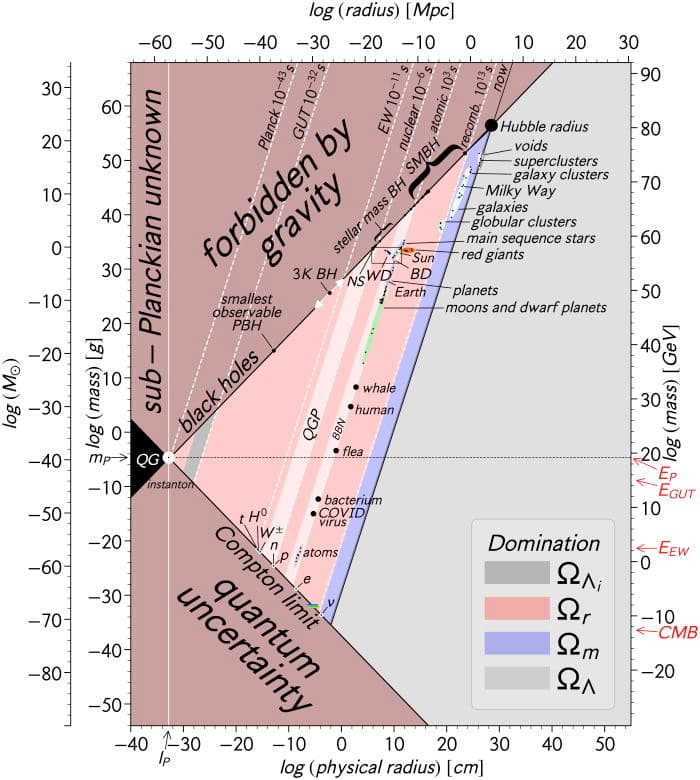Cody Reeder of the Cody’sLab YouTube channel asked the question, “What’s above one square metre on the surface of the Earth?” Here’s his answer, analysing the density profile of the Earth’s atmosphere and discovering how little, based upon the average density of mass-energy in the universe, exists between the top of the Earth’s atmosphere and the edge of the observable universe. Let’s watch the video.
But is projecting a one meter square pipe out into the heavens the best way to pose this question? If you imagine the Earth tiled with one metre squares, each at the bottom of a column extending outward, there’s a lot of space between the columns as you get more distant from Earth, until they fill a negligible fraction of space.
Instead, let’s consider looking above and below the square in the way property rights (such as mineral rights and air rights) are often defined: based upon a pyramid with apex at the centre of the Earth and base the boundary of the property on the surface, then extending upward into the sky and beyond. That way, the conception of property encompasses everything below and above (“Cuius est solum, eius est usque ad coelum et ad inferos”), except as constrained by laws such as flyover rights and limits on exploitation of deep-Earth resources. The extension of property rights to space may have its origin in science fiction (see, for example, the machinations by D. D. Harriman in Heinlein’s The Man Who Sold the Moon), but already exists, for example in assignment and ownership of longitudinal slots in geostationary orbit.
By this pyramidal definition, what’s above and what’s below that one metre patch in your back yard? Let’s start with some geometry. Looking down toward the centre of the Earth, we have a right rectangular pyramid with a square base one metre in length and width and a vertex at the centre of the Earth, around 6371 km below. The volume of a pyramid is:
so we can calculate (all calculations below are done with Fourmilab Units Calculator, insignificant digits discarded):
(((1 metre)^2) * 6371 km) / 3 = 2123666 m^3
The mean density of the Earth is 5.5134 g/cm³, so the mass within our pyramid is about 1.17\times 10^{10} kg, which is about twice the mass of the Great Pyramid of Giza in Egypt. As Cody demonstrated in his video, the mass of the atmosphere above is, by comparison, almost insignificant, around ten tonnes (10^4 kg) of mostly nitrogen and oxygen.
But what if we extend the pyramid upward and outward, all the way to the edge of the observable universe, taking “usque at coelum” to its (il)logical extreme? Putting on the trigonometry hat, we calculate the half-angle between the apex of the pyramid and the centre of one of the edges of its base at the Earth’s surface as:
The radius of the observable universe is around 4.4\times 10^{26} metres (14.3 gigaparsecs), so we can then compute the half-width of the edges of the projected pyramid base as 3.45\times 10^{19} metres, or around 3650 light years. This sounds big, but recall that (ignoring clustering), the average distance between galaxies is around 9.9 million light years and galaxies range in size between 3000 and 300,000 light years, so the probability a square that large will contain part of a galaxy is small.
With the size of the projected base in hand, we can now compute the volume of the pyramid extending from the centre of the Earth, through the one metre square on its surface, all the way out to the observable horizon. Plugging into the volume formula above, we get 7\times 10^{65} cubic metres, which is around ten thousand times the volume of the Milky Way galaxy.
The mean density of the universe depends upon what we wish to include in its definition. If we use just normal baryonic matter (stars, galaxies, dust, gas, planets, star-nosed moles, etc.) it’s 4.2\times 10^{-28}~{\rm kg}/{\rm m}^3, and if we include dark matter and dark energy according to the concordance model of cosmology, that increases to 9.9\times 10^{-27}~{\rm kg}/{\rm m}^3 (about six protons per cubic metre).
So, the mass-energy within this cosmic pyramid is then (neglecting that within the Earth and its atmosphere, which as we will see, is lost in the round-off) is, for baryonic matter, 2.9\times 10^{38}~{\rm kg} or, including dark matter and energy, 6.9\times 10^{39}~{\rm kg}, This is a lot of mass, but the baryonic mass is still around 1400 times smaller than the visible (baryonic) mass of the Milky Way Galaxy.
In conclusion, there’s a lot more mass above than below, but the universe is still an awfully empty place. Looking at it another way, those who obsess on “only one Earth” and argue we should renounce the human endowment and destiny to bring the universe to life in order to “concentrate on problems here and now” should bear in mind than when standing on a one metre square of Earth’s surface, there are around 2.5\times 10^{28} times as many resources above your head than below your feet. This is a number larger than the number of atoms in a human body.
And that’s before we figure out how to use the dark matter and energy.

